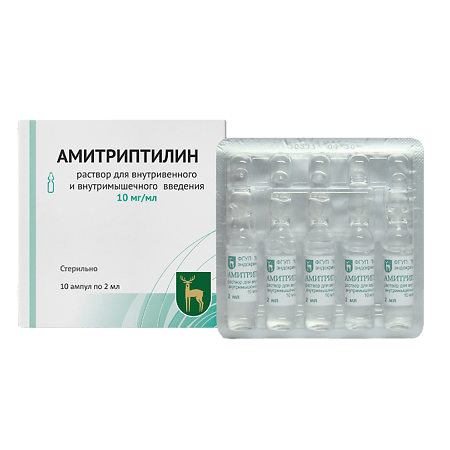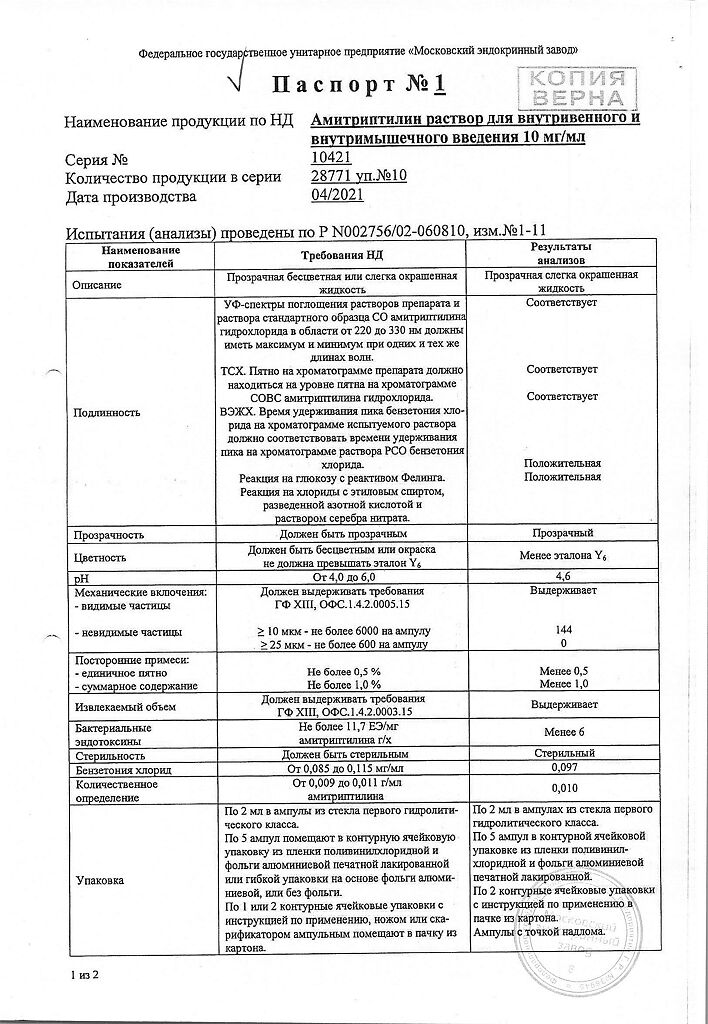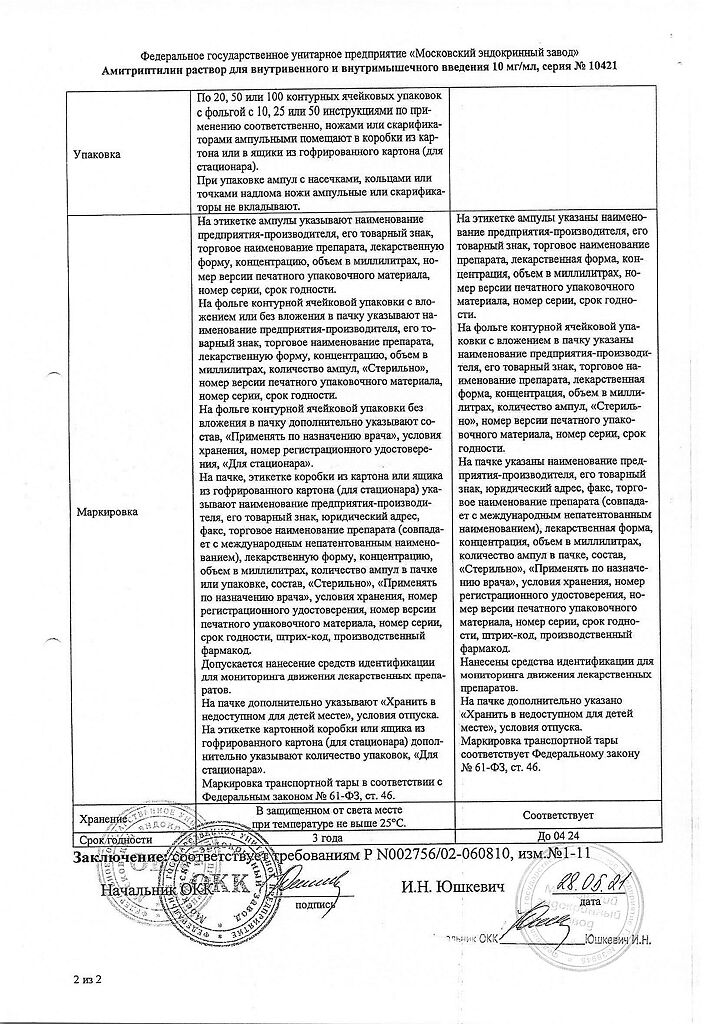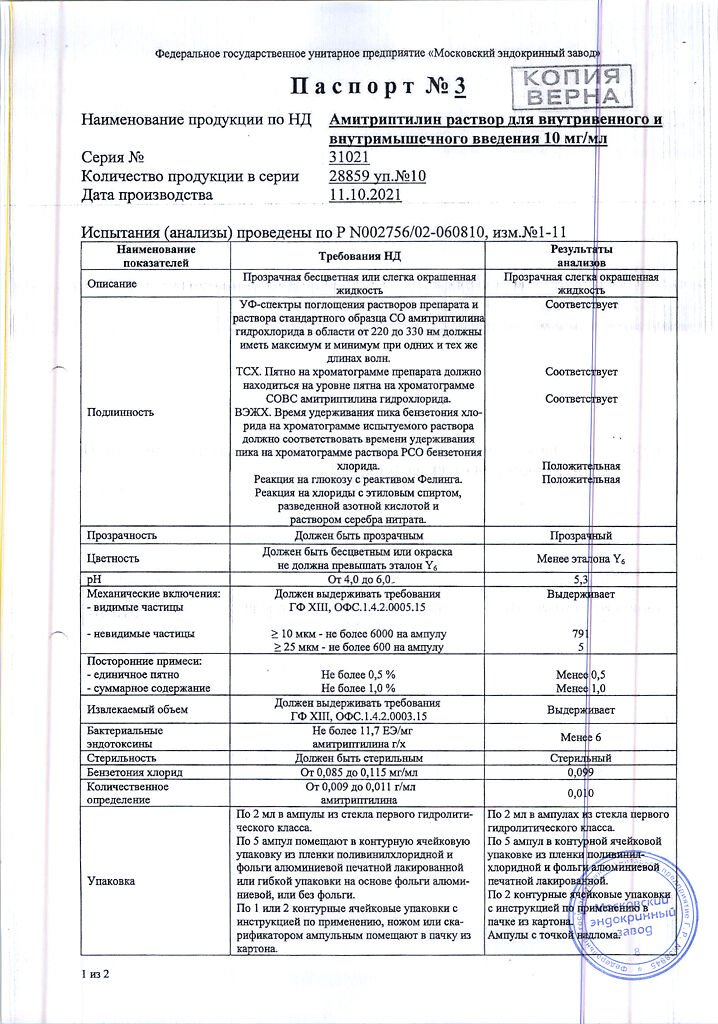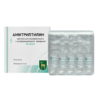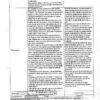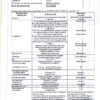No products in the cart.
Amitriptyline, 10 mg/ml 2 ml 10 pcs
€1.00
Out of stock
(E-mail when Stock is available)
Description
Pharmacodynamics
Amitriptyline is an antidepressant (tricyclic antidepressant). It also has some analgesic (of central genesis), H2-histamine blocking and antiserotonin action, helps eliminate nocturnal urinary incontinence and reduces appetite. It has strong peripheral and central anticholinergic effect due to high affinity to m-cholinoreceptors; strong sedative effect due to affinity to H1-histamine receptors and alpha-adrenoblocking effect.
It has the properties of an antiarrhythmic drug (drug) of subgroup Ia, like quinidine in therapeutic doses slows ventricular conduction (in overdose it can cause severe intraventricular blockade). The mechanism of antidepressant action is associated with an increase in the concentration of noradrenaline in synapses and/or serotonin in the central nervous system (reduction of their reverse absorption). Accumulation of these neurotransmitters occurs as a result of inhibition of their reuptake by the membranes of presynaptic neurons.
With long-term use it reduces the functional activity of beta-adrenergic and serotonin receptors of the brain, normalizes adrenergic and serotonergic transmission, restores the balance of these systems that are disturbed in depressed states. In anxiety-depressive states it reduces anxiety, agitation and depressive manifestations. The mechanism of antiulcer action is conditioned by its ability to block H2-histamine receptors in the parietal cells of the stomach as well as by its sedative and m-cholinoblocking action (in cases of stomach and duodenal ulcer it reduces pain and accelerates the healing of the ulcer).
The efficacy in nocturnal urinary incontinence appears to be due to anticholinergic activity leading to increased bladder distension capacity, direct beta-adrenergic stimulation, alpha-adrenergic agonist activity accompanied by increased sphincter tone, and central serotonin takeover blockade. It has a central analgesic effect, which is thought to be related to changes in monoamine concentrations in the CNS, especially serotonin, and to effects on endogenous opioid systems. The mechanism of action in bulimia nervosa is unclear (it may be similar to that in depression). The distinct effect of the drug in bulimia patients both without and with depression is shown, and bulimia reduction can be observed without concomitant weakening of depression itself. During general anesthesia, it reduces blood pressure (BP) and body temperature. It does not inhibit monoamine oxidase (MAO). Antidepressant effect develops within 2-3 weeks after the beginning of application.
Intake
Amitriptyline is highly absorbed. Maximum blood plasma concentration (Cmax) is 0.04-0.16 µg/ml. Equilibrium concentration is reached approximately 1-2 weeks after the start of treatment. Concentration of amitriptyline in tissues is higher than in blood plasma. Bioavailability of amitriptyline by different routes of administration is 33-62%, its active metabolite nortriptyline – 46-70%. Volume of distribution (Vd) is 5-10 l/kg. Effective therapeutic concentrations of amitriptyline in blood are 50-250 ng/ml, for nortriptyline (its active metabolite) – 50-150 ng/ml. Binding with plasma proteins is 92-96%. Amitriptyline passes through histohematological barriers, including the blood-brain barrier (including nortriptyline), penetrates the placental barrier, is excreted in breast milk at plasma-like concentrations.
Metabolism
Metabolism of amitriptyline is performed mainly due to demethylation (CYP2D19, CYP3A isoenzymes) and hydroxylation (CYP2D6 isoenzyme) with subsequent conjugation with glucuronic acid. Metabolism is characterized by significant genetic polymorphism. The main active metabolite is a secondary amine, nortriptyline. The metabolites cis- and trans-10-hydroxyamitriptyline and cis- and trans-10-hydroxynortriptyline have a similar activity profile to nortriptyline, although their action is much weaker.
Demethylnortriptyline and amitriptyline-N-oxide are present in negligible concentrations in plasma; the latter metabolite has almost no pharmacological activity. Compared with amitriptyline, all metabolites have a significantly less pronounced m-cholin-blocking effect.
The main factor determining renal clearance and, therefore, plasma concentrations is the hydroxylation rate. A small proportion of people have genetically determined delayed hydroxylation.
Elimination
The plasma elimination half-life (T1/2) is 10-28 h for amitriptyline and 16-80 h for nortriptyline. The average total clearance of amitriptyline is 39.24±10.18 l/h. Amitriptyline is excreted mainly by the kidneys and through the intestine as metabolites. About 50% of administered amitriptyline is excreted in the urine as 10-hydroxy-amitriptyline and its conjugate with glucuronic acid, about 27% is excreted as 10-hydroxy-nortriptyline and less than 5% of amitriptyline is excreted as the parent substance and nortriptyline. Complete excretion of amitriptyline from the body occurs within 7 days.
Elderly patients
Elderly patients have increased elimination half-life and decreased clearance of amitriptyline due to decreased metabolic rate.
Patients with hepatic impairment
Hepatic impairment may lead to slower metabolism of amitriptyline and increased plasma concentrations.
Patients with impaired renal function
In patients with impaired renal function, excretion of metabolites of amitriptyline and nortriptyline is delayed, although metabolism as such is not altered. Due to binding to blood proteins amitriptyline is not removed from the blood plasma by dialysis.
Indications
Indications
Endogenous Depression and Other Depressive Disorders.
Active ingredient
Active ingredient
Composition
Composition
1 ml of solution for intramuscular administration contains:
the active substance:
amitriptyline hydrochloride (in terms of amitriptyline) – 10 mg.
How to take, the dosage
How to take, the dosage
Intramuscularly in a dose of 10-20-30 mg up to 4 times a day, the dose should be increased gradually, the maximum daily dose is 150 mg; after 1-2 weeks, if possible, switch to oral administration of the drug. Duration of treatment should not exceed 6-8 months.
In the elderly, lower doses are administered and increased more slowly.
Amitriptyline can be administered in usual doses in patients with renal insufficiency.
If the patient’s condition does not improve within 3-4 weeks of treatment, further therapy is not advisable.
Interaction
Interaction
When using ethanol and CNS depressant drugs (including other antidepressants, barbiturates, benzadiazepines and general anesthetics) together, a significant increase in CNS depressant effect, respiratory depression and hypotensive effect are possible. Increases sensitivity to beverages containing ethanol. Increases anticholinergic effect of drugs with anticholinergic activity (e.g. phenothiazines, anti-Parkinsonian drugs, amantadine, atropine, biperidine, antihistamine drugs), which increases the risk of side effects (CNS, vision, bowel and bladder).
When used concomitantly with antihistamines, clonidine – increase in CNS depression; with atropine – increases the risk of paralytic ileus; with drugs that cause extrapyramidal reactions – increase the severity and frequency of extrapyramidal effects. Concomitant use of amitriptyline and indirect anticoagulants (coumarin derivatives or indadeon) may increase the anticoagulant activity of the latter. Amitriptyline may increase depression caused by glucocorticosteroids (GCS).
When used concomitantly with anticonvulsants it is possible to increase CNS depression, decrease the seizure activity threshold (when used in high doses) and decrease the effectiveness of the latter. Drugs for the treatment of thyrotoxicosis increase the risk of agranulocytosis. Reduces the effectiveness of phenytoin and alpha-adrenoblockers. Microsomal oxidation inhibitors (cimetidine) prolong T1/2 and increase the risk of toxic effects of amitriptyline (dosage reduction by 20-30% may be required), microsomal liver enzyme inducers (barbiturates, carbamazepine, phenytoin, nicotine and oral contraceptives) decrease the plasma concentration and decrease the effectiveness of amitriptyline. Fluoxetine and fluvoxamine increase the plasma concentration of amitriptyline (it may be necessary to reduce the dose of amitriptyline by 50%).
When co-administered with choline blockers, phenothiazines and benzodiazepines – mutual enhancement of sedative and central choline blocking effects and increased risk of epileptic seizures (decreased seizure threshold); phenothiazines, in addition, may increase the risk of neuroleptic malignant syndrome. Concomitant use of amitriptyline with clonidine, guanethidine, betanidine, reserpine and methyldopa decreases the hypotensive effect of the latter; with cocaine, the risk of cardiac arrhythmias. Estrogen-containing oral contraceptives and estrogens may increase bioavailability of amitriptyline; antiarrhythmic drugs (like quinidine) increase the risk of arrhythmia (slowdown of metabolism of amitriptyline is possible).
Co-use with disulfiram and other acetaldehydrogenase inhibitors provokes delirium. Incompatible with MAO inhibitors (increased frequency of periods of hyperpyrexia, severe seizures, hypertensive crises and patient death are possible). Pimozide and probucol may exacerbate cardiac arrhythmias, which is manifested by prolongation of the Q-T interval on the ECG. It increases the effects of epinephrine, norepinephrine, isoprenaline, ephedrine and phenylephrine on the SCS (including when these drugs are part of local anesthetics) and increases the risk of cardiac rhythm disturbances, tachycardia, severe arterial hypertension.
In co-administration with alpha-adrenergic stimulants for intranasal administration or for use in ophthalmology (with significant systemic absorption) the vasoconstrictor effect of the latter may increase. When co-administration with thyroid hormones – mutual enhancement of the therapeutic effect and toxic effects (include cardiac arrhythmias and stimulating effect on the CNS). M-cholinoblockers and antipsychotic drugs (neuroleptics) increase the risk of hyperpyrexia (especially in hot weather). Co-administration with other hematotoxic drugs may increase hematotoxicity.
Special Instructions
Special Instructions
Before treatment it is necessary to control BP (in patients with low or labile BP it may decrease even more); during treatment – control of peripheral blood (in some cases agranulocytosis may develop, therefore it is recommended to monitor the blood picture, especially if body temperature increases, development of flu-like symptoms and tonsillitis), during long-term therapy – control of cardiovascular and liver functions.
The treatment with amitriptyline in elderly patients should be carefully monitored, with minimal doses of the drug and their gradual increase, in order to avoid the development of delirium disorder, hypomania and other complications. In elderly patients and patients with cardiovascular diseases, monitoring of heart rate (HR), BP, ECG is indicated. On ECG there may appear clinically insignificant changes (smoothing of the T wave, ST-segment depression, widening of QRS complex).
While using the drug in high doses there is increasing the possibility of cardiac arrhythmias and severe arterial hypotension. The development of these conditions is also possible when using conventional doses in patients with heart disease.
The drug may be used only in the hospital under medical supervision with bed rest during the first days of therapy.
It is necessary to be careful about the rapid transition to the upright position from the position “lying” or “sitting”.
Alcohol should be avoided during treatment.
Prescribed no earlier than 14 days after withdrawal of MAO inhibitors, starting with low doses.
Withdrawal syndrome may develop if the drug is stopped suddenly after long-term treatment.
Symptoms of withdrawal: headache, nausea, vomiting, diarrhea, malaise, sleep disorders, unusual dreams, agitation, motor anxiety, irritability and general ill health.
. Amitriptyline in doses above 150 mg/day lowers the seizure threshold (the risk of seizures in predisposed patients as well as in the presence of other predisposing factors to seizure syndrome, such as brain damage of any etiology, the simultaneous use of antipsychotic drugs (neuroleptics), during alcohol withdrawal or withdrawal of drugs with anticonvulsant properties, such as benzodiazepines should be considered).
Simultaneous use of amitriptyline, neuroleptics and hypnotics (droperidol) should be avoided. Extreme caution should be exercised if simultaneous use is necessary.
When amitriptyline is used to treat the depressive component of schizophrenia, psychotic symptoms may worsen – in this case it is advisable to prescribe amitriptyline in combination with neuroleptics.
Severe depression is characterized by the risk of suicidal behavior, which may persist until significant remission is achieved. In this regard, at the beginning of treatment a combination with drugs from the group of benzodiazepines or neuroleptic drugs and constant medical supervision (entrusting to trusted persons the storage and dispensing of drugs) may be indicated.
In patients with cyclic affective disorders during the depressive phase, manic or hypomanic states may develop during therapy (dose reduction or drug withdrawal and administration of antipsychotic drug is necessary). After these states have subsided, if indicated, treatment at low doses may be resumed.
Because of the possible cardiotoxic effects, caution is required when treating patients with thyrotoxicosis or patients receiving thyroid hormone preparations.
In combination with electroconvulsive therapy is prescribed only with close medical supervision.
In predisposed patients and elderly patients may provoke the development of drug psychosis, mainly at night (after discontinuation of the drug passes within a few days).
May cause paralytic intestinal obstruction, mainly in patients with chronic constipation, the elderly or in patients forced to follow bed rest.
We should be careful when prescribing the drug in patients with liver dysfunction; plasma concentrations of amitriptyline should be monitored if possible.
Patients with renal insufficiency can be prescribed the drug in usual dosages.
The drug is contraindicated in patients with prostatic hyperplasia, especially with urinary retention (see section “Contraindications.
Patients receiving tricyclic/tetracyclic antidepressants concomitantly with local and general anesthetics may be at increased risk of arrhythmia and blood pressure drop.
Before general or local anesthesia, the anesthesiologist should be advised that the patient is taking amitriptyline.
The anticholinergic action may result in decreased tear production and a relative increase in the amount of mucus in the lacrimal fluid, which may result in corneal epithelial damage in patients who use contact lenses.
Patients should inform their dentist about taking amitriptyline.
Dry mouth can lead to changes in oral mucosa, inflammation, burning sensation and tooth decay. Regular check-ups with your dentist are recommended. There may be an increased need for riboflavin.
Taking amitriptyline may change the body’s tolerance to insulin and glucose, which requires correction of antidiabetic therapy in patients with diabetes. The state of depression may also affect glucose metabolism.
Cases of hyperpyrexia have been reported with tricyclic antidepressants when prescribed simultaneously with anticholinergic or neuroleptic medications, especially in hot weather.
Animal reproduction studies have shown adverse effects on the fetus, and adequate and well-controlled studies in pregnant women have not been conducted. In pregnant women the drug should be used only if the estimated benefit to the mother exceeds the potential risk to the fetus.
It penetrates into breast milk and may cause drowsiness in infants.
To avoid the development of “withdrawal” syndrome in infants (manifested by shortness of breath, drowsiness, intestinal colic, increased nervous excitability, hypotension or hypertension, tremor, or spastic phenomena) amitriptyline administration should be phased out at least 7 weeks before expected delivery.
Children are more sensitive to acute overdose, which should be considered dangerous and potentially fatal to them.
Suicidal/suicidal ideation or clinical deterioration of the course of the disease
Depression is accompanied by an increased risk of suicide. This risk persists until substantial remission is achieved and may occur spontaneously during the course of therapy. Because the antidepressant effect does not develop until several weeks after the start of treatment, the patient should be closely monitored until clinical improvement is achieved. Increase of suicide risk in early terms of recovery is possible.
Constant medical supervision of patients with suicidal thoughts and suicide attempts in anamnesis is necessary, including against the background of therapy. The storage and dispensing of medications to such patients should be done by trusted persons.
Amitriptyline (like other antidepressants) can itself increase the incidence of suicide in persons under 25 years of age. Therefore, when prescribing amitriptyline to patients under 25 years of age, the risk of suicide should be weighed against the benefit of the antidepressant. In short-term studies, the risk of suicide is not increased in people over 25 years of age, and it is slightly decreased in people over 65 years of age.
Any depressive disorder itself increases the risk of suicide, so all patients should be monitored during antidepressant treatment for early detection of impairment or behavioral changes as well as suicidal tendencies. Effect on ability to drive vehicles and mechanisms
During treatment, caution should be exercised when driving motor transport and engaging in other potentially dangerous activities requiring increased concentration and rapid psychomotor reactions.
Contraindications
Contraindications
Side effects
Side effects
Blood organs: rare – suppression of bone marrow function, agranulocytosis, leukopenia, thrombocytopenia, eosinophilia; frequency unknown – purpura.
Metabolism: very often – weight gain, increased appetite, rarely – decreased appetite, very rarely – syndrome of inadequate hypersecretion of antidiuretic hormone; frequency of unknown – hypo- or hyperglycemia, hyponatremia (decreased vasopressin production), hypoproteinemia.
Nervous system disorders: very common – somnolence, tremor, dizziness, headaches, confusion (in elderly patients, confusion may manifest as anxiety, agitation, elements of hallucinatory delirium), disorientation; often – reduced concentration, impaired taste (dysgeusia), peripheral neuropathy (paresthesias), agitation, increased frequency and intensity of epileptic seizures, extrapyramidal symptoms ataxia, akathisia, parkinsonism, dystonic reactions, tardive dyskinesia, slowness of speech; infrequently – cognitive impairment, hypomania, mania, anxiety, insomnia, “nightmare” dreams; rarely – aggression, delirium (in elderly people), hallucinations (in schizophrenic patients), seizures very rare – during treatment with amitriptyline and soon after its termination suicidal thoughts, suicidal behavior; frequency is unknown – fainting, depersonalization, increased depression, yawning, activation of symptoms of psychosis, myoclonus, dysarthria, changes on electroencephalogram (EEG).
Senses: very common – decrease of visual acuity, accommodation disorders; common – mydriasis; infrequent – increase of intraocular pressure, tinnitus, rare – loss of accommodation capacity, aggravation of narrow-angle glaucoma in elderly people.
Cardio-vascular system: very common – palpitations, tachycardia, orthostatic hypotension, common – atrioventricular block (AV blockade), intraventricular conduction disorders, registered only on ECG, but not manifested clinically (prolongation of QQ and QT intervals, QRS complex dilation, signs of Gis bundle branch block, non-specific changes of ST interval or T wave, including in patients without heart disease).patients without heart disease); rarely – arterial hypertension, arrhythmia, rarely – myocardial infarction.
Digestive system disorders: very common – dry mouth, constipation, nausea; common – gum atrophy, oral inflammation, tooth decay, burning sensation in the mouth; infrequent – diarrhea, vomiting, tongue swelling; rare – increased salivary glands, paralytic bowel obstruction, hepatitis (including liver dysfunction and cholestatic jaundice); common unknown – heartburn, gastralgia, darkened tongue.
The skin: very common – hyperhidrosis; infrequent – skin rash, skin itching, urticaria, angioedema; rarely – alopecia, photosensitization reactions, hair loss.The urinary system: infrequent – urinary retention, the frequency is unknown – pollicuria.
Reproductive system: very common – decreased or increased libido, often – in men – erectile dysfunction, impotence, rarely – in women – galactorrhea, delayed orgasm, loss of orgasm attainment, in men – increased testicular size (edema), delayed ejaculation, gynecomastia.
Laboratory parameters: frequently – ECG changes: prolongation of PQ and QT intervals, QRS complex expansion, signs of Gis pedicle blockade, nonspecific changes of ST interval or T wave; rarely – abnormal state of liver function tests, increased activity of blood alkaline phosphatase and transaminase.
Others: frequently – fatigue; rarely – pyrexia, frequency unknown – decreased sweating, enlarged lymph nodes.
Symptoms of withdrawal: after long-term use with abrupt termination of use, adverse reactions such as nausea, vomiting, diarrhea, headache, malaise, insomnia, unusual dreams, unusual agitation, irritability may occur; after long-term use with gradual withdrawal – irritability, sleep disorders, unusual dreams. Association with taking the drug has not been established: lupus-like syndrome (arthritis migrans, the appearance of antinuclear antibodies and positive rheumatoid factor), aguesia.
Some of the adverse reactions, such as headache, tremor, impaired concentration, constipation and reduced libido may be manifestations of depression and disappear as depression resolves.
Overdose
Overdose
CNS disorders: drowsiness, stupor, coma, ataxia, hallucinations, anxiety, psychomotor agitation, decreased ability to concentrate, disorientation, confusion, dysarthria, hyperreflexia, muscle rigidity, choreoathetosis, epileptic syndrome.
Cardiovascular system: decreased arterial pressure (BP), tachycardia, arrhythmia, intracardiac conduction disorders, electrocardiogram (ECG) changes (especially QRS) typical for intoxication with tricyclic antidepressants, shock; in very rare cases – cardiac arrest.
Other: respiratory depression, dyspnea, cyanosis, vomiting, hyperthermia, mydriasis, increased sweating, oliguria or anuria.
Symptoms develop 4 hours after overdose, reach a maximum in 24 hours and last for 4-6 days. If overdose is suspected, especially in children, the patient shall be hospitalized.
Treatment: Symptomatic and supportive therapy; with severe anticholinergic effects (decreased BP, arrhythmia, coma, myoclonic seizures) – cholinesterase inhibitors (physostigmine is not recommended due to increased risk of seizures); maintenance of BP and water-electrolyte balance. Control of cardiac functions (including ECG) for 5 days (relapse may occur after 48 hours or later), anticonvulsant therapy, artificial pulmonary ventilation (AVR) and other resuscitation measures are indicated.
Hemodialysis and forced diuresis are ineffective.
Additional information
| Shelf life | 3 years. |
|---|---|
| Conditions of storage | In a light-protected place at a temperature not exceeding 25 ºC. |
| Manufacturer | Moscow Endocrine Plant, Russia |
| Medication form | solution |
| Brand | Moscow Endocrine Plant |
Related products
Buy Amitriptyline, 10 mg/ml 2 ml 10 pcs with delivery to USA, UK, Europe and over 120 other countries.

